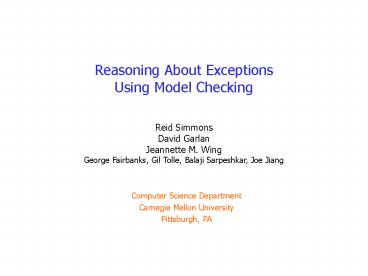Reasoning About Exceptions Using Model Checking PowerPoint PPT Presentation
Title: Reasoning About Exceptions Using Model Checking
1
Reasoning About ExceptionsUsing Model Checking
Reid SimmonsDavid GarlanJeannette M.
WingGeorge Fairbanks, Gil Tolle, Balaji
Sarpeshkar, Joe Jiang
- Computer Science Department
- Carnegie Mellon University
- Pittsburgh, PA
2
Outline
- Why Model Check Exceptions?
- Approach
- IEL
- MOPED
- Translations
- Gotchas
- Example
- Vending Machine
3
Exceptions in Programming Languages
- Raising Exceptions
- Throw of named/typed exceptions
- Catch by nearest matching handler
- Exceptions may form inheritance hierarchy
- Clean up Construct
- Finally / Unwind-protect
- Executed in both nominal and exceptional
situations - Semantics
- Termination (C, Java, Lisp)
- Resumption (Mesa, Eiffel, TDL)
4
Why Hard?
- Non-Local Flow of Control
- Context of Catch Frames Determined Dynamically
- Clean Up Construct Adds Additional Pathways
- Hard to Reason About All Possible Execution Paths
- Impossible To Do So Purely Locally
5
Overview of Our Approach
6
Intermediate Exception Language (IEL)
- Captures Commonalities of Exception Handling
Among Different Languages - Focuses on Control-Flow Constructs Relevant to
Reasoning About Exceptions - Catch/Throw/Finally
- Iteration and Conditionals
- Break and Return
- Assignment
- Procedures
- Hierarchical Exceptions
- Minimal Data Representation
- No value-returning functions
7
IEL Example Resource Locking
- var locked int
- exception e1
- procedure main ()
- locked 0
- while true
- try
- lock()
- randomException()
- unlock()
- catch e1
- / unlock() /
- procedure lock ()
- if locked 1 then
- error()
- if locked 0 then
- locked 1
- procedure randomException ()
- if (p) throw e1
8
MOPED
- Model Checker for Push-Down Automata
- Stefan Schwoons PhD Thesis
- Symbolic Model Checker
- Handles Procedures with Local Variables
- Need to Explicitly Handle Frame Axioms
- Verifies LTL State Reachability Formulae
- Currently cannot handle LTL formulae involving
variables - Minimal Data Representation
9
Translating IEL ? MOPED
- Create Local Translation Rules for Each IEL
Construct - Assign ( x y)
- q ltprocNgt --gt q ltprocN1gt (x y
frameAllExcept(x)) - Conditional ( if p then stmt)
- q ltprocNgt --gt q ltprocN1gt if true (p 1
frameAll) - q ltprocNgt --gt q ltprocNgt if false (p 0
frameAll) - stmt
- qltprocNgt
- Throw ( throw ex)
- q ltprocNgt --gt q ltprocExgt (ex 1 )
- Try/Catch ( try tryblock catch ex
catchblock) - q ltprocNgt --gt qltprocTrygt jump past catch
(frameAll) - q ltprocExgt --gt qltprocCatchgt caught ex (ex 1
) - q ltprocExgt --gt qltprocNgt didnt catch ex (ex 0
) - catchBlock translation
10
Gotchas
- Exception Hierarchy
- (Nested) Finally Blocks
- Break and Return Statements
11
Modeling Exception Hierarchy
- exception e0
- exception e1 extends e0
- try
- throw e1
- catch e0
- Preprocess IEL Code to Determine Hierarchy
- Throw Explicitly Sets Exception and All Its
Parents - q ltprocNgt --gt q ltprocExgt (e1 1 e0 1 )
- Matching Catch Clears All Exceptions
- q ltprocNgt --gt q ltprocN1gt (e0 0 e1 0
e2 0 )
12
Modeling Finally Blocks
- try
- if q then throw e1
- finally
- try
- if p then throw e2
- catch e1 x x / 0
- x x 1
- Store State of Exceptions Upon Entering Finally
Block - Clear All Exceptions Before Executing Finally
Block - Restore Exception State at End of Finally Block,
Unless a New Exception Was Raised
13
Modeling Nested Finally Blocks
NL 0 EL -1
- try
- throw e1
- finally
- try
- if p then throw e2
- finally
- x x 1
- x x 1
- Store State of Exceptions Upon Entering Finally
- Plus Keep Track of nesting level and exception
level - Increment nesting level on Entering, and
Decrement on Exit - Clear All Exceptions Before Executing Finally
Block - Before Entering Finally Block with an Exception,
Set exception level to nesting level - Propagate Exception on Exit if exception level
equals nesting level
try throw e1 finally try
throw e2 catch e2 finally
x x 1
NL 1
EL 0
NL 2
EL 1/0
NL 1
NL 0
14
Modeling Break and Return Statements
- Break and Return Interact in Interesting Ways
with Exceptions and Finally Blocks
while (x lt 5) try if x 3 then
try break
finally try
throw e1 finally
x x 5
catch e1 x
x1 x x - 2
while (x lt 5) try if x 3 then
try throw e1
finally try
break finally
x x 5
catch e1 x
x1 x x - 2
Approach Treat Break and Return as
Exceptions that do not Propagate!!
15
Example Vending Machine
- Model of Vending Machine
- Machine vends product, if it has that product in
stock and sufficient put in - Represented by Java program that has significant
exceptions - From TSE article by Sinha Harrold
- Verify that if Money is Put in the Machine,
Eventually it will either Return Money or Vend
Product - Static analysis is insufficient
- Hand-coded IEL program from Java
sourceAutomated IEL ? MOPED translation - Found bug in the program (could keep on adding
money indefinitely no limit)
16
Ongoing and Future Work
- Translating Java ? IEL
- Work in Progress
- Parser and Most of Translator Exist
- Main Difficulty in Dealing with Objects
- Complex data structures, Inheritance, Dynamic
memory allocation - Add Specification Language to IEL
- Translate Other Languages (C, Lisp)
- Model Resumption Model of Exceptions
- Test on Software with Significant Exceptions

